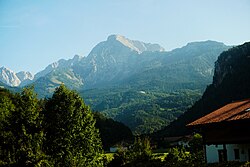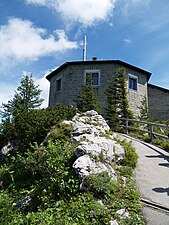Kehlsteinhaus
| Eagle's Nest | |
|---|---|
Kehlsteinhaus | |
 The Kehlsteinhaus in 2017
| |
 Location within Germany
| |
| General information | |
| Status | Completed |
| Type | Chalet |
| Location | Obersalzberg |
| Town or city | Berchtesgaden |
| Country | Germany |
| Coordinates | 47°36′40″N 13°02′30″E |
| Elevation | 1,834 m (6,017 ft) |
| Completed | 1938 |
| Inaugurated | 20 April 1939 |
| Website | |
| www.kehlsteinhaus.de/en/ | |
The Kehlsteinhaus (known in English as the Eagle's Nest) is a Nazi-constructed building erected atop the summit of the Kehlstein, a rocky outcrop that rises above Obersalzberg near the southeast German town of Berchtesgaden. It was used exclusively by members of the Nazi Party for government and social meetings. It was visited on 14 documented instances by Adolf Hitler. Today, it is open seasonally as a restaurant, beer garden, and tourist site.
Construction

The Kehlsteinhaus sits on a ridge atop the Kehlstein, a 1,834 m (6,017 ft) subpeak of the Hoher Göll that rises above the town of Berchtesgaden. It was commissioned by Martin Bormann in the summer of 1937. Paid for by the Nazi Party, it was completed in 13 months. Twelve workers died during its construction.
A 4 m (13 ft) wide approach road climbs 800 m (2,600 ft) over 6.5 km (4.0 mi); it includes five tunnels and one hairpin turn. It cost 30 million ℛ︁ℳ︁ to build (about $247 million USD, inflation-adjusted for 2022). Hitler's birthday in April 1939 was considered a deadline for the project's completion, so work continued throughout the winter of 1938, even at night with the worksite lit by searchlights.
From a large car park, a 124 m (407 ft) entry tunnel leads to an ornate elevator that ascends the final 124 m (407 ft) to the building. The tunnel is lined with marble and was originally heated with warm air from an adjoining service tunnel. However it was normal for visiting high-officials to be driven through the tunnel to the elevator. Their driver would then have to reverse the car for the entire length of the tunnel as there was no space to turn.
The inside of the large elevator is surfaced with polished brass, Venetian mirrors, and green leather. The building's main reception room is dominated by a fireplace of red Italian marble presented by Italian dictator Benito Mussolini, which was damaged by Allied soldiers chipping off pieces to take home as souvenirs. The building had a completely electric appliance kitchen, which was unusual in 1937, but was never used to cook meals; instead meals were prepared in town and taken to the kitchen on the mountain top to be reheated. The building also has heated floors, with heating required for at least two days before visitors arrived. A MAN submarine diesel engine and an electrical generator were installed in an underground chamber close to the main entrance, to provide back-up power.
Much of the furniture was designed by Paul László.
Use

Hitler first visited on 16 September 1938 and returned to inaugurate it on 20 April 1939, his 50th birthday, though it was not intended as a birthday gift.
There are two ways to approach and enter the building: the road and the Kehlsteinhaus elevator. Hitler did not trust the elevator, continually expressed his reservations of its safety, and disliked using it; his biggest fear was that the elevator's winch mechanism on the roof would attract a lightning strike. Bormann took great pains to never mention the two serious lightning strikes that occurred during construction.
The Kehlsteinhaus lies several miles directly above the Berghof, Hitler's summer home. In a rare diplomatic engagement, Hitler received departing French ambassador André François-Poncet on 18 October 1938, here. It was he who coined the name "Eagle's Nest" for the building while later describing the experience; this has since become a commonly used name for the Kehlsteinhaus.
A wedding reception for Eva Braun's sister Gretl was held there following her marriage to Hermann Fegelein on 3 June 1944. While Hitler more often than not left the entertaining duties to others, he believed the house presented an excellent opportunity to entertain important and impressionable guests.
Referred to as the "D-Haus", short for "Diplomatic Reception House", the Kehlsteinhaus is often conflated with the teahouse on Mooslahnerkopf Hill near the Berghof, which Hitler walked to daily after lunch. The teahouse was demolished by the Bavarian government after the war, due to its connection to Hitler.
Allied capture
The Kehlsteinhaus was a target for the 25 April 1945 Bombing of Obersalzberg. This was a Royal Air Force bombing raid conducted by No. 1, No. 5, and No. 8 Group and No. 617 Squadron. The small house proved an elusive target for the force of 359 Avro Lancasters and 16 de Havilland Mosquitoes, which bombed and severely damaged the Berghof area instead.
It is uncertain which Allied military unit was the first to reach the Kehlsteinhaus. The matter is compounded by popular confusion of it being taken on 4 May by forward elements of the 2e Division Blindée (specifically "La Nueve", a company composed of Spanish Republicans), with the town of Berchtesgaden, taken by elements of the US 7th Infantry Regiment.
Reputedly, members of the 7th went as far as the elevator to the Kehlsteinhaus, with at least one person claiming that he and a partner continued on to the top. In a Library of Congress interview and more recent interviews, Herman Louis Finnell of the 3rd Infantry Division said that his regiment entered the Berghof, not the Kehlsteinhaus. However, the 101st Airborne claims it was first both to Berchtesgaden and the Kehlsteinhaus.
Meanwhile, troops of the 2e Division Blindée, including Laurent Touyeras, Georges Buis, and Paul Répiton-Préneuf, were present on the night of 4-5 May, and took Hitler's personal items and several photographs before Americans arrived and before leaving on 10 May at the request of U.S. command. So say the numerous testimonies of the Spanish soldiers who went along with them.
Undamaged in the 25 April bombing raid, the Kehlsteinhaus was subsequently used by the Allies as a military command post until 1960, when it was handed back to the State of Bavaria.
Today



Today the building is owned by a charitable trust, and serves as a restaurant offering indoor dining and an outdoor beer garden. It is a popular tourist attraction due to its historical significance. The road has been closed to private vehicles since 1952 because it is too narrow for two-way travel. The house can be reached on foot (in two hours) from Obersalzberg, or by bus from the Documentation Center. The Documentation Centre directs visitors to the coach station where tickets are purchased. The bus ticket serves as an entry ticket, as it permits the holder entry to the building's elevator. The buses are specially modified to ascend the steep road leading to the peak. The Kehlsteinhaus interior offers little information about its past. Photos displayed and described along the wall of the sun terrace document the pre-construction location and later history.
Informal tours of the Kehlsteinhaus can be booked through the website. Due to concern about neo-Nazis and post-war Nazi sympathizers, no external guides are permitted to conduct tours.
The lower rooms are not part of the restaurant but can be visited with a guide. They offer views of the building's past through plate-glass windows. Graffiti left by Allied troops is still clearly visible in the surrounding woodwork. The red Italian marble fireplace remains damaged by Allied souvenir hunters, though this was later halted by signage posted that the building was U.S. government property, and damage to it was cause for disciplinary action. Hitler's small study is now a storeroom for the cafeteria.
A trail leads above the Kehlsteinhaus towards the Mannlgrat ridge reaching from the Kehlstein to the summit of the Hoher Göll. The route, which is served by a Klettersteig, is regarded as the easiest to the top.
Gallery
-
Fireplace in the Kehlsteinhaus, a present from Mussolini. Note the damage to the three central stones, which were chipped by Allied souvenir hunters.
-
The tunnel to the Kehlsteinhaus elevator
-
Kehlsteinhaus from below
-
 Panorama view of Berchtesgaden and Obersalzberg from the Kehlsteinhaus
Panorama view of Berchtesgaden and Obersalzberg from the Kehlsteinhaus -
 The Kehlsteinhaus can just be made out on the peak of the tree-covered mountain on the center right of the image
The Kehlsteinhaus can just be made out on the peak of the tree-covered mountain on the center right of the image
![Fireplace in the Kehlsteinhaus, a present from Mussolini. Note the damage to the three central stones, which were chipped by Allied souvenir hunters.[24]](http://upload.wikimedia.org/wikipedia/commons/thumb/0/06/Kehlsteinhaus1.JPG/250px-Kehlsteinhaus1.JPG)



